|
Dr. Manoj Sharma Professor University Business School Panjab University, Chandigarh |
Prof. Rajesh Shankar Sharma Assistant Professor Institute of Management C/o DAV College, Chandigarh |
Prof. Nidhi Kaushal Assistant Professor Prof. Nidhi Kaushal |
India is a diverse country in terms of language, food, taste etc. Talking about the food, Indian mother has given utmost importance to the home cooked food that includes cereal, wheat and rice. In this dynamic food industry, the presence of various fast food outlets in organized and unorganized retail market has changed the taste and preference towards selection of food. The presence of quick service restaurants like Mc. Donald, KFC, Pizza Hut, Dominos etc has reshaped the conventional food taste. This study measures the impact of demographic features on consumers’ decision in selecting Quick service restaurant and fast food.
Keywords: QSR, behavior, decision making
The influence of the demographic features on consumer decision making in QSR: An Indian Perspective
To measure the impact of demographic features on consumers’ decision in selecting QSR & fast food
An open ended questionnaire is prepared and distributed among the respondents through online mode. A sample size of 96 respondents is selected. Simple random sampling, a part of probability sampling is used. Chi Square test is implemented to analyse the impact using SPSS software.
We have found taste as the major reason that attract consumer towards fast food. Most of the respondents would like to eat fast food as snacks. They don’t treat it as breakfast, lunch or dinner. Gender and fast food eating frequency per month are independent of each other. Education factor does not play significant role in calculating the price of fast food meal. There is no significant impact of marital status on consumer decision making as why he/she is consuming fast food.
The outcome of this research is related with only fast food sector and cover organized fast food retail outlet. Online distribution of questionnaire was done through google forms and responses were recorded through online mode only.
Customers go to the restaurants to enjoy the food, ambience (Saad Andaleeb and Conway (2006). They may go to street vendor to satisfy their local food taste buds. Customer visit quick service restaurant, observe the menu and decides their food preference (Elbel, Gyamfi, & Kersh, 2011). Also they may be moving on road side or street and then came across any unorganized fast food outlet and decides their food preference. Fast food is available in both organized and unorganized retail market (Downs, Thow, Ghosh-Jerath, & Leeder, 2014). Taste, easily preparation, easily availability, restaurant location may be any factor that attract the customer towards fast food outlet (Kara, Kaynak, and Kucukemiroglu (1995). Demographic features play important role in deciding the food preferences (Chen (2007). These features may affect their decision related with food selection, dine in or take away, selection of fast food outlet, eating fasting food in breakfast, lunch, snacks or dinner etc. Demographic features of population includes sex, income level, education, marital status, religion, occupation, birth rate, death rate, average size of family (Glick, 1988).
A study conducted by Ehsan (2012) considered price, food variety, promotional deals and well on time service delivery as the imperative factors that create a base for the selection of quick service restaurants. The author conducted this study in different cities and found a difference in choice and selection of fast food restaurants. Anand (2011) concluded that eating out with family/friends, service scape, taste, high disposable income in urban India are the main determinants effecting their food/restaurant choice. Jani and Han (2011) discovered customer satisfaction depends upon the service encounter and trust as compared to the price factor. Izquierdo-Yusta, Gómez-Cantó, Pelegrin-Borondo, and Martínez-Ruiz (2018) discussed the three groups in which the customers can be segmented i.e. mainly utilitarian, mainly hedonic, ethical values group. All these groups differ from each other on the basis of trust, satisfaction and loyalty. Ryu, Lee, and Gon Kim (2012) found that restaurant image largely depend upon food, physical environment and service. (Binkley, 2006) studied that demographic features still affect the consumer food preferences. Food nutritional value has little or no affect on selection of fast food. Health conscious consumers consume lower amount of fast food.
Open ended questionnaire was distributed through online mode via Google forms. Total numbers of 120 responses were received out of which 96 responses were found to be complete. Simple random sampling, a part of probability sampling, was used. Customer satisfaction was analysed by five point Likert scale being 1 Highly Dissatisfied, 2 Dissatisfied, 3 neutral, 4 Satisfied, 5 Highly Satisfied. Demographic features being used in the study are gender, age, education level, marital status and employment status. Impacts of demographic features were measured on the following:-
1. Frequency of eating fast food per month 2. Order type i.e. Dine in, take away or drive through 3. Choosing favorite restaurant (Mc Donald, KFC, Pizza Hut etc) 4. Calculating fast food meal cost 5. Fast food type (Burger, fried chicken, pizza etc.) 6. Reason for choosing (location, convenience, taste etc.) 7. Eating time i.e. Breakfast, lunch, snack or dinner After going through the review of literature, following hypothesis have been formulated
Hypothesis H(o): There is no significant impact of demographic features on decision making in quick service restaurant. H(a): There is a significant impact of demographic features on decision making in quick service restaurant. In order to accept or reject above mentioned hypothesis, following hypothesis have been formulated. H(o): There is no significant impact of gender on consumption of fast food per month H(o): There is no significant impact of education on calculating the meal cost H(o): There is no significant impact of marital status on finding out the reason as why to eat fast food H(o): There is no significant impact of age on choosing order mode (dine in, take away, drive through) H(o): There is no significant impact of employment status on timing of eating fast food (breakfast, lunch, snack or dinner) H(o): There is no significant impact of gender on selection of fast food outlet H(o): There is no significant impact of education level on selection of fast food
Characteristics Frequency Percentage Gender Male 64 66.7 Female 32 33.3 Age 17-27 42 43.8 28-38 36 37.5 Above 38 18 18.8 Education level High School 4 4.2 Bachelor Degree 42 43.8 Master Degree 40 41.7 Ph.D 10 10.4
Single 34 35.4 Married 58 60.4 Widow 2 2.1 Divorced 2 2.1 Employment status Self Employed 22 22.9 Homemaker 4 4.2 Student 14 14.6 Retired 4 4.2 Salaried 50 52.1 Fresher 2 2.1 Consumption of fast food Rarely eat fast food 16 16.7 Once a month 26 27.1 2-4 times a month 32 33.3 5-10 times a month 18 18.8 More than 10 times 4 4.2 Taking order Eat in 56 58.3 Take away 16 16.7 Drive Thru 6 6.2 Eat in, take away 12 12.5 Eat in, take away, drive thru 4 4.2 Eat in, drive thru 2 2.1 Favourite Restaurant Mc Donald 12 12.5 Burger King 6 6.2 KFC 4 4.2 Subway 16 16.7 Pizza Hut 2 2.1 Dominos 14 14.6 Nothing Special 2 2.1 Owenfresh 2 2.1 KFC, Subway, Dominos 14 14.6 Mc Donald, Subway, Dominos 10 10.4 Dominos, street food 6 6.2 Mc Donald, Dominos 4 4.2 Mc Donald, KFC, Burger King, Subway, Pizza Hut, Dominos 4 4.2 Meal Cost Less than Rs 50 6 6.2 Rs 51-100 18 18.8 Rs 101-150 16 16.7 Rs 151-200 22 22.9 Above 200 34 35.4 Fast Food type Burger 18 18.8 Pizza 6 6.2 Fries 8 8.3 Fried Chicken 14 14.6 Subway Sandwich 32 33.3 Wrap 4 4.2 Pasta 2 2.1 Fries, Fried Chicken, wrap 10 10.4 Burger, Fried Chicken 2 2.1 Reason for Choosing Convenience 14 14.6 Taste 30 31.2 Price 6 6.2 Variety of options 20 20.8 Location 8 8.3 Limited time for cooking 2 2.1 As a treat 4 4.2 Taste, Price, Location 4 4.2 Convenience, Variety of options, Location 2 2.1 Price, Location 4 4.2 Price, Location, As a treat 2 2.1 When You eat? Lunch 14 14.6 Snack 50 52.1 Dinner 32 33.3 Overall Satisfaction Highly Dissatisfied 2 2.1 Dissatisfied 6 6.2 Neutral 14 14.6 Satisfied 52 54.2 Highly Satisfied 22 22.9 In order to accept and reject the main hypothesis more hypothesis are formulated. H(o): There is no significant impact of gender on consumption of fast food per month In order to accept or reject above hypothesis, Chi Square Test is used:
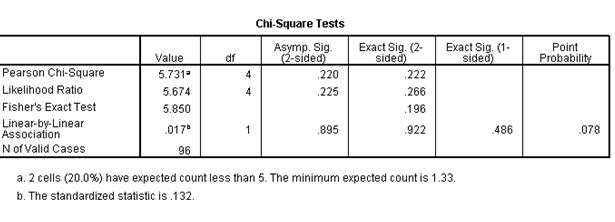
Obtained p value received is greater than the alpha .05 both in the case of Pearson Chi-square test and Fisher’s exact test, so we accept the null hypothesis that Gender and frequency of eating fast food per month are independent of each other. In other words, there is no significant impact of gender on the decision making to eat fast food. H(o): There is no significant impact of education on calculating the meal cost Education and Meal Cost
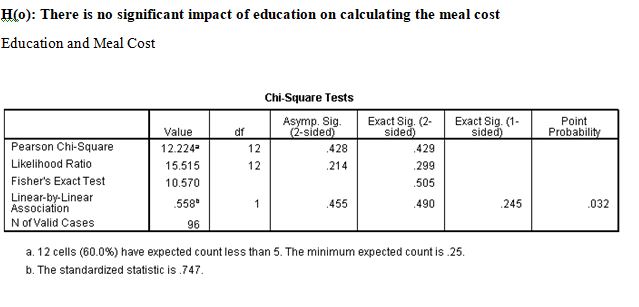
Obtained p value received is greater than the alpha .05 both in the case of Pearson Chi-square test and Fisher’s exact test, so we accept the null hypothesis that education and calculating meal cost are independent of each other. In other words, there is no significant impact of education on calculating meal cost. H(o): There is no significant impact of marital status on finding out the reason as why to eat fast food Marital status and Reason to eat fast food
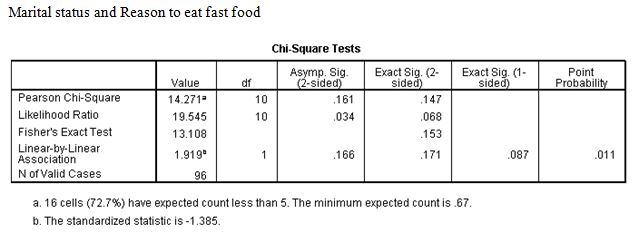
Obtained p value received is greater than the alpha .05 both in the case of Pearson Chi-square test and Fisher’s exact test, so we accept the null hypothesis that marital status and reason to eat fast food are independent of each other. In other words, there is no significant impact of marital status on consumer decision making as why to eat fast food. H(o): There is no significant impact of age on choosing order mode (dine in, take away, drive through) Age and orders mode
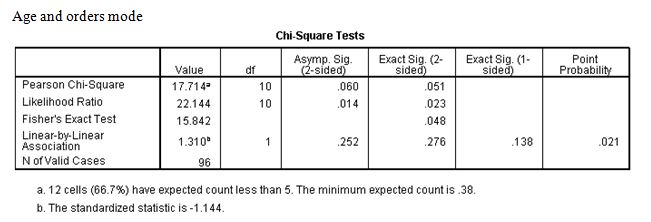
Talking about Fisher’s exact test, Obtained p value is smaller than the alpha .05 value. We reject the null hypothesis that age and order mode are independent of each other. In other words age factor play a significant role in deciding whether a customer will dine in a restaurant or will get the food packed or will collect it from drive through. H(o): There is no significant impact of employment status on timing of eating fast food (breakfast, lunch, snack or dinner)

Talking about Fisher’s exact test, Obtained p value is smaller than the alpha .05 value. We reject the null hypothesis that employment status and time of consuming fast food are independent of each other. In other words, there is a significant impact of employment status on time of consuming fast food. H(o): There is no significant impact of gender on selection of fast food outlet
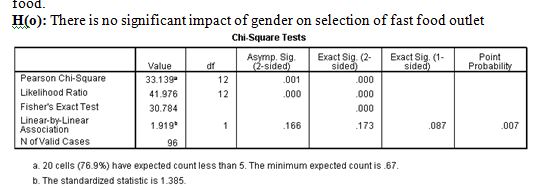
Obtained p value received is lower than the alpha .05 both in the case of Pearson Chi-square test and Fisher’s exact test, so we the reject the null hypothesis that gender and selection of fast food outlet are independent of each other. In other words, there is a significant impact of gender on consumer decision making regarding selection of fast food outlet. H(o): There is no significant impact of education level on selection of fast food
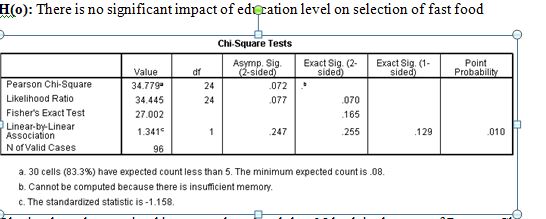
Obtained p value received is greater than the alpha .05 both in the case of Pearson Chi-square test and Fisher’s exact test, so we accept the null hypothesis that education level and selection of fast food are independent of each other. In other words, there is no significant impact of education level on consumer decision making regarding selection of fast food.
1. Majority of the respondents consume fast food 2-4 times a month. This is a positive signal for the owners of fast food outlets. 2. Majority of the respondents want to eat fast food inside restaurants. They will ignore other options like packing the food or collecting the food from drive through. 3. Most of the respondents’ choice is subway. This reflects a consumer has become diet and health conscious. 4. Most of the respondents feel the meal cost to be more than Rs 200/- per visit. 5. Majority of the respondents order subway sandwich over pizza, burger, french fries etc. 6. Taste is a major reason that attract consumer towards fast food. 7. Most of the respondents would like to eat fast food as snacks. They don’t treat it as breakfast, lunch or dinner. 8. There is no significant impact of gender on the consumer decision making as to how many times he/she is going to eat fast food per month. 9. There is no significant impact of education on calculating meal cost. Education factor does not play significant role in calculating the price of fast food meal. 10. Marital status and finding out the reason as why consumer consumes fast food are independent of each other. In other words, there is no significant impact of marital status on consumer decision making as why he/she is consuming fast food. 11. We have found a significant impact of age on choosing order mode. Age factor play an important role in deciding whether a customer will eat fast food in restaurant or he/she will get it packed or he/she will collect via drive through. 12. We have found a significant impact of employment status on timing of consuming fast food. Whether a customer will eat fast food as breakfast, lunch, snack or dinner will depend upon his employment status. 13. There is a significant impact of gender on consumer decision making regarding selection of fast food outlet. 14. There is no significant impact of customer education level on selection of fast food. Education does not play significant role in choosing burger, pizza, subway sandwich, French fries etc. 15. Majority of the respondents are satisfied with the food and services offered by quick service restaurants.
Anand, R. (2011). A study of determinants impacting consumers food choice with reference to the fast food consumption in India. Society and Business Review, 6(2), 176-187. • Binkley, J. K. (2006). The effect of demographic, economic, and nutrition factors on the frequency of food away from home. Journal of consumer Affairs, 40(2), 372-391. • Chen, M.-F. (2007). Consumer attitudes and purchase intentions in relation to organic foods in Taiwan: Moderating effects of food-related personality traits. Food Quality and Preference, 18(7), 1008-1021. • Downs, S. M., Thow, A. M., Ghosh-Jerath, S., & Leeder, S. R. (2014). Developing interventions to reduce consumption of unhealthy fat in the food retail environment: a case study of India. Journal of hunger & environmental nutrition, 9(2), 210-229. • Ehsan, U. (2012). Factors important for the selection of fast food restaurants: an empirical study across three cities of Pakistan. British Food Journal, 114(9), 1251-1264. • Elbel, B., Gyamfi, J., & Kersh, R. (2011). Child and adolescent fast-food choice and the influence of calorie labeling: a natural experiment. International journal of obesity, 35(4), 493. • Glick, P. C. (1988). Fifty years of family demography: A record of social change. Journal of Marriage and the Family, 861-873. • Izquierdo-Yusta, A., Gómez-Cantó, C. M., Pelegrin-Borondo, J., & Martínez-Ruiz, M. P. (2018). Consumers’ behaviour in fast-food restaurants: a food value perspective from Spain. British Food Journal. • Jani, D., & Han, H. (2011). Investigating the key factors affecting behavioral intentions: Evidence from a full-service restaurant setting. International Journal of Contemporary Hospitality Management, 23(7), 1000-1018. • Kara, A., Kaynak, E., & Kucukemiroglu, O. (1995). Marketing strategies for fast-food restaurants: a customer view. International Journal of Contemporary Hospitality Management, 7(4), 16-22. • Ryu, K., Lee, H.-R., & Gon Kim, W. (2012). The influence of the quality of the physical environment, food, and service on restaurant image, customer perceived value, customer satisfaction, and behavioral intentions. International Journal of Contemporary Hospitality Management, 24(2), 200-223. • Saad Andaleeb, S., & Conway, C. (2006). Customer satisfaction in the restaurant industry: an examination of the transaction-specific model. Journal of services marketing, 20(1), 3-11.